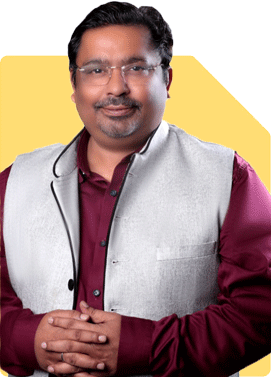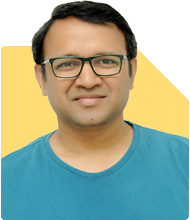Newborn in 2023: What's the Best Education Investment?
Ramalingam Kalirajan |8291 Answers |Ask -Follow
Mutual Funds, Financial Planning Expert - Answered on Apr 15, 2025
He has an MBA in finance from the University of Madras and is a certified financial planner.
He is the director and chief financial planner at Holistic Investment, a Chennai-based firm that offers financial planning and wealth management advice.... more

I want to invest in my childs education born in 2023. What is the best thing in the market?
This is a thoughtful and wise move.
Your child born in 2023 will likely need funds for college around 2040.
That gives you a long investment horizon of 15+ years.
This gives enough time for compounding to work well.
Let me share a 360-degree investment roadmap for this goal.
This plan is written in a simple tone but with professional depth.
Let us now explore the best available options in the market today.
Understand the Nature of the Goal
Education is a non-negotiable goal.
You cannot postpone or compromise it easily.
It is a high-cost goal due to inflation in education fees.
Hence, your investment must beat education inflation.
Regular savings in a bank will not be enough.
You need growth assets with better long-term returns.
Also, safety and discipline are important.
Tax efficiency matters because the goal is long-term.
You must track progress regularly and adjust if needed.
You must not withdraw before maturity, even during emergencies.
Begin with a Clear Goal Plan
Estimate the year your child will need funds.
For UG courses, it could be in 2040.
For PG, it may be 2043 or later.
Estimate cost of education in today’s value.
Then adjust for education inflation.
Usually, education inflation is around 8–10%.
Do not ignore living costs, books, and hostel fees.
Add buffer for foreign education or special courses.
Split the goal into 2 phases: UG and PG.
Assign different timelines and amounts to each.
Then plan SIPs or lump sums accordingly.
Why Fixed Deposits Are Not Suitable
FD returns are lower than education inflation.
Tax on FD interest reduces actual returns.
Compounding works poorly in FDs.
FDs do not allow automatic step-up in investment.
They also don’t offer any growth during long tenure.
Reinvesting maturity amount each time is inefficient.
Your long-term wealth will remain stagnant.
They are only okay for short-term parking.
Not ideal for a 15 to 20-year education goal.
Avoiding Index Funds for Education Planning
Index funds only copy the market.
They lack human intelligence and decision-making.
They do not outperform in volatile markets.
They carry full market risk without active adjustment.
In falling markets, they fall fully with no defense.
Index funds cannot shift from poor sectors.
Actively managed funds can change strategy mid-way.
Fund managers can shift to better sectors.
Hence, for education goals, prefer active mutual funds.
Debt Mutual Funds: Use Them Carefully
Debt funds are useful for short-term education goals.
Also useful 2-3 years before goal maturity.
They reduce risk from sudden equity fall.
But returns are not high for long-term.
Tax treatment is as per income tax slab.
You may pay more tax if in higher slab.
So use debt funds only during last few years.
Do not start education investing with them.
Gold ETFs or Sovereign Gold Bonds: Limited Use
Gold may give inflation-like returns over time.
But it is not consistent year after year.
No dividend or income from gold investment.
Gold prices can stay flat for years.
SGBs are tax-free after 8 years, but lack flexibility.
Hence, use only 5–10% of corpus in gold.
Do not depend only on gold for education goal.
Best Core Strategy: Active Mutual Funds
These are managed by skilled fund managers.
They aim to beat market by smart decisions.
They adjust portfolio based on market situation.
They change allocation between sectors and themes.
They select good companies and avoid weak ones.
Over long term, they can outperform passive funds.
Also, they are well-regulated and transparent.
SIP in active funds gives rupee cost averaging.
Over 15 years, this can create strong corpus.
These are ideal for long-term child education needs.
Disadvantages of Direct Plans
In direct funds, you invest without any guidance.
You need to monitor and rebalance yourself.
Most investors do not review portfolio regularly.
No help to handle underperforming funds.
No one reminds or guides you during market changes.
You may miss out on newer, better opportunities.
Wrong selection or wrong asset mix causes damage.
Instead, choose regular plans through Certified Financial Planner.
You get professional support with goal-based planning.
You stay on track and reduce mistakes.
Systematic Investment Plan (SIP): Best Route
SIP builds habit and discipline in investing.
It removes the pressure of timing the market.
Even small amounts can become big with time.
You can increase SIP every year as income grows.
It helps in averaging cost during market ups and downs.
You remain invested even during market falls.
SIP is a good match for long-term education goals.
Use Step-up SIP for Higher Growth
Step-up SIP means increasing SIP yearly.
This matches your salary or business growth.
It helps beat inflation better over 15 years.
You invest more without much effort.
This results in higher maturity amount.
A Certified Financial Planner can help calculate ideal step-up.
Mix of Equity Mutual Funds Based on Child’s Age
When your child is 0 to 10 years old:
Allocate 90–100% to equity mutual funds.
Use a mix of large-cap, flexi-cap and mid-cap funds.
Add small-cap only if you can tolerate volatility.
Avoid thematic or sectoral funds now.
Keep it simple and diversified.
When your child turns 11–13 years:
Gradually reduce mid- and small-cap exposure.
Shift 20–30% into conservative hybrid funds.
Reduce equity to about 70–80%.
From 14–16 years onward:
Move 40–60% to short-duration debt funds.
This will protect the goal from equity volatility.
Keep rest in flexi-cap and large-cap funds.
1–2 years before goal:
Move entire corpus to liquid and short-term debt funds.
Ensure capital is safe and ready for use.
Use Goal Tracker Every Year
Track if your corpus is growing as per plan.
Review fund performance every year.
Replace underperforming funds with better ones.
Adjust SIP amount if needed.
Increase SIP if inflation rises more than expected.
Use XIRR to check overall returns.
A Certified Financial Planner will do this yearly.
Use Separate Folio for Education Goal
Don’t mix this goal with other investments.
Use one folio for this specific purpose.
This gives clear visibility and control.
You won’t accidentally withdraw for other needs.
It keeps your mental focus intact.
Insurance is Not Investment
Do not mix insurance with child education.
Avoid ULIPs, endowment plans or money-back policies.
They give poor returns and long lock-in.
Mostly 3–5% return only, after charges.
Instead, buy pure term insurance separately.
Invest remaining in good mutual funds.
If you hold any investment-cum-insurance policy:
Do a cost-benefit analysis.
If returns are low, surrender and reinvest.
Redeem carefully to avoid exit load or tax.
Emergency Fund and Term Insurance
Always keep 6–12 months expense as emergency fund.
This avoids breaking child investment during crisis.
Use liquid mutual funds or FD for this.
Also buy term insurance to protect child’s goal.
It should cover at least 15–20 times your annual income.
If anything happens to you, the child’s goal stays safe.
Tax Impact and Smart Withdrawals
Equity MF gains above Rs 1.25 lakh taxed at 12.5%.
This applies only after one year holding.
If sold within 1 year, 20% tax applies.
For debt funds, tax as per income tax slab.
Plan withdrawals over 2–3 financial years.
This reduces tax burden and keeps money liquid.
A Certified Financial Planner can guide tax-efficient exit.
Avoid Lump Sum Late Investment
Don’t wait to invest in final 3–5 years.
Lump sum at that time is risky and stressful.
It may coincide with market downturn.
Start early and do SIP consistently.
Early investment reduces pressure later.
Final Insights
Starting early is your biggest advantage.
You already made a great first step.
Continue SIPs for 15 years with discipline.
Do not panic during market fluctuations.
Review every year with a Certified Financial Planner.
Adjust based on inflation, market and child’s career path.
Keep insurance separate and invest only in mutual funds.
Never stop SIP mid-way unless emergency.
Child’s future deserves consistent planning and care.
Best Regards,
K. Ramalingam, MBA, CFP,
Chief Financial Planner,
www.holisticinvestment.in
https://www.youtube.com/@HolisticInvestment
You may like to see similar questions and answers below
Omkeshwar Singh | Answer |Ask -Follow
Head, Rank MF - Answered on May 14, 2021
Ambareesh Baliga | Answer |Ask -Follow
Stock Market Expert - Answered on Feb 02, 2023
Nikunj Saraf |308 Answers |Ask -Follow
Mutual Funds Expert - Answered on Jun 13, 2023
Ramalingam Kalirajan |8291 Answers |Ask -Follow
Mutual Funds, Financial Planning Expert - Answered on May 21, 2024
Dr Nagarajan Jsk |346 Answers |Ask -Follow
NEET, Medical, Pharmacy Careers - Answered on Apr 25, 2025
Nayagam P P |4463 Answers |Ask -Follow
Career Counsellor - Answered on Apr 25, 2025
Nayagam P P |4463 Answers |Ask -Follow
Career Counsellor - Answered on Apr 25, 2025
Nayagam P P |4463 Answers |Ask -Follow
Career Counsellor - Answered on Apr 25, 2025
Patrick Dsouza |1030 Answers |Ask -Follow
CAT, XAT, CMAT, CET Expert - Answered on Apr 25, 2025
Dr Dipankar Dutta |1168 Answers |Ask -Follow
Tech Careers and Skill Development Expert - Answered on Apr 25, 2025
Dr Dipankar Dutta |1168 Answers |Ask -Follow
Tech Careers and Skill Development Expert - Answered on Apr 25, 2025
Dr Dipankar Dutta |1168 Answers |Ask -Follow
Tech Careers and Skill Development Expert - Answered on Apr 25, 2025
Radheshyam Zanwar |1566 Answers |Ask -Follow
MHT-CET, IIT-JEE, NEET-UG Expert - Answered on Apr 25, 2025
Radheshyam Zanwar |1566 Answers |Ask -Follow
MHT-CET, IIT-JEE, NEET-UG Expert - Answered on Apr 25, 2025



























